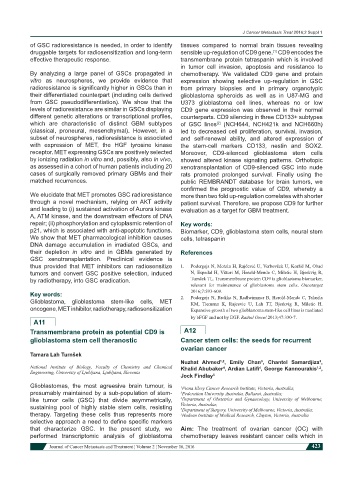Page 433 - Read Online
P. 433
J Cancer Metastasis Treat 2016;2 Suppl 1
of GSC radioresistance is needed, in order to identify tissues compared to normal brain tissues revealing
druggable targets for radiosensitization and long-term sensible up-regulation of CD9 gene. CD9 encodes the
[1]
effective therapeutic response. transmembrane protein tetraspanin which is involved
in tumor cell invasion, apoptosis and resistance to
By analyzing a large panel of GSCs propagated in chemotherapy. We validated CD9 gene and protein
vitro as neurospheres, we provide evidence that expression showing selective up-regulation in GSC
radioresistance is significantly higher in GSCs than in from primary biopsies and in primary organotypic
their differentiated counterpart (including cells derived glioblastoma spheroids as well as in U87-MG and
from GSC pseudodifferentiation). We show that the U373 glioblastoma cell lines, whereas no or low
levels of radioresistance are similar in GSCs displaying CD9 gene expression was observed in their normal
different genetic alterations or transcriptional profiles, counterparts. CD9 silencing in three CD133+ subtypes
which are characteristic of distinct GBM subtypes of GSC lines (NCH644, NCH421k and NCH660h)
[2]
(classical, proneural, mesenchymal). However, in a led to decreased cell proliferation, survival, invasion,
subset of neurospheres, radioresistance is associated and self-renewal ability, and altered expression of
with expression of MET, the HGF tyrosine kinase the stem-cell markers CD133, nestin and SOX2.
receptor. MET expressing GSCs are positively selected Moreover, CD9-silenced glioblastoma stem cells
by ionizing radiation in vitro and, possibly, also in vivo, showed altered kinase signaling patterns. Orthotopic
as assessed in a cohort of human patients including 20 xenotransplantation of CD9-silenced GSC into nude
cases of surgically removed primary GBMs and their rats promoted prolonged survival. Finally using the
matched recurrences. public REMBRANDT database for brain tumors, we
confirmed the prognostic value of CD9, whereby a
We elucidate that MET promotes GSC radioresistance more than two fold up-regulation correlates with shorter
through a novel mechanism, relying on AKT activity patient survival. Therefore, we propose CD9 for further
and leading to (i) sustained activation of Aurora kinase evaluation as a target for GBM treatment.
A, ATM kinase, and the downstream effectors of DNA
repair; (ii) phosphorylation and cytoplasmic retention of Key words:
p21, which is associated with anti-apoptotic functions. Biomarker, CD9, glioblastoma stem cells, neural stem
We show that MET pharmacological inhibition causes cells, tetraspanin
DNA damage accumulation in irradiated GSCs, and
their depletion in vitro and in GBMs generated by References
GSC xenotransplantation. Preclinical evidence is
thus provided that MET inhibitors can radiosensitize 1. Podergajs N, Motaln H, Rajčević U, Verbovšek U, Koršič M, Obad
tumors and convert GSC positive selection, induced N, Espedal H, Vittori M, Herold-Mende C, Miletic H, Bjerkvig R,
by radiotherapy, into GSC eradication. Turnšek TL. Transmembrane protein CD9 is glioblastoma biomarker,
relevant for maintenance of glioblastoma stem cells. Oncotarget
Key words: 2. 2016;7:593-609.
Podergajs N, Brekka N, Radlwimmer B, Herold-Mende C, Talasila
Glioblastoma, glioblastoma stem-like cells, MET KM, Tiemann K, Rajcevic U, Lah TT, Bjerkvig R, Miletic H.
oncogene, MET inhibitor, radiotherapy, radiosensitization Expansive growth of two glioblastoma stem-like cell lines is mediated
by bFGF and not by EGF. Radiol Oncol 2013;47:330-7.
A11
Transmembrane protein as potential CD9 is A12
glioblastoma stem cell theranostic Cancer stem cells: the seeds for recurrent
ovarian cancer
Tamara Lah Turnšek
Nuzhat Ahmed , Emily Chan , Chantel Samardjiza ,
3
3
1,2
National Institute of Biology, Faculty of Chemistry and Chemical Khalid Abubaker , Ardian Latifi , George Kannourakis ,
1,2
4
4
Engineering, University of Ljubljana, Ljubljana, Slovenia
Jock Findlay 5
Glioblastomas, the most agreesive brain tumour, is 1 Fiona Elsey Cancer Research Institute, Victoria, Australia;
presumably maintained by a sub-population of stem- 2 Federation University Australia, Ballarat, Australia;
like tumor cells (GSC) that divide asymmetrically, 3 Department of Obstetrics and Gynaecology, University of Melbourne,
sustaining pool of highly stable stem cells, resisting Victoria, Australia;
Department of Surgery, University of Melbourne, Victoria, Australia;
4
therapy. Targeting these cells thus represents more 5 Hudson Institute of Medical Research, Clayton, Victoria, Australia
selective approach a need to define specific markers
that characterize GSC. In the present study, we Aim: The treatment of ovarian cancer (OC) with
performed transcriptomic analysis of glioblastoma chemotherapy leaves resistant cancer cells which in
Journal of Cancer Metastasis and Treatment ¦ Volume 2 ¦ November 16, 2016 423

